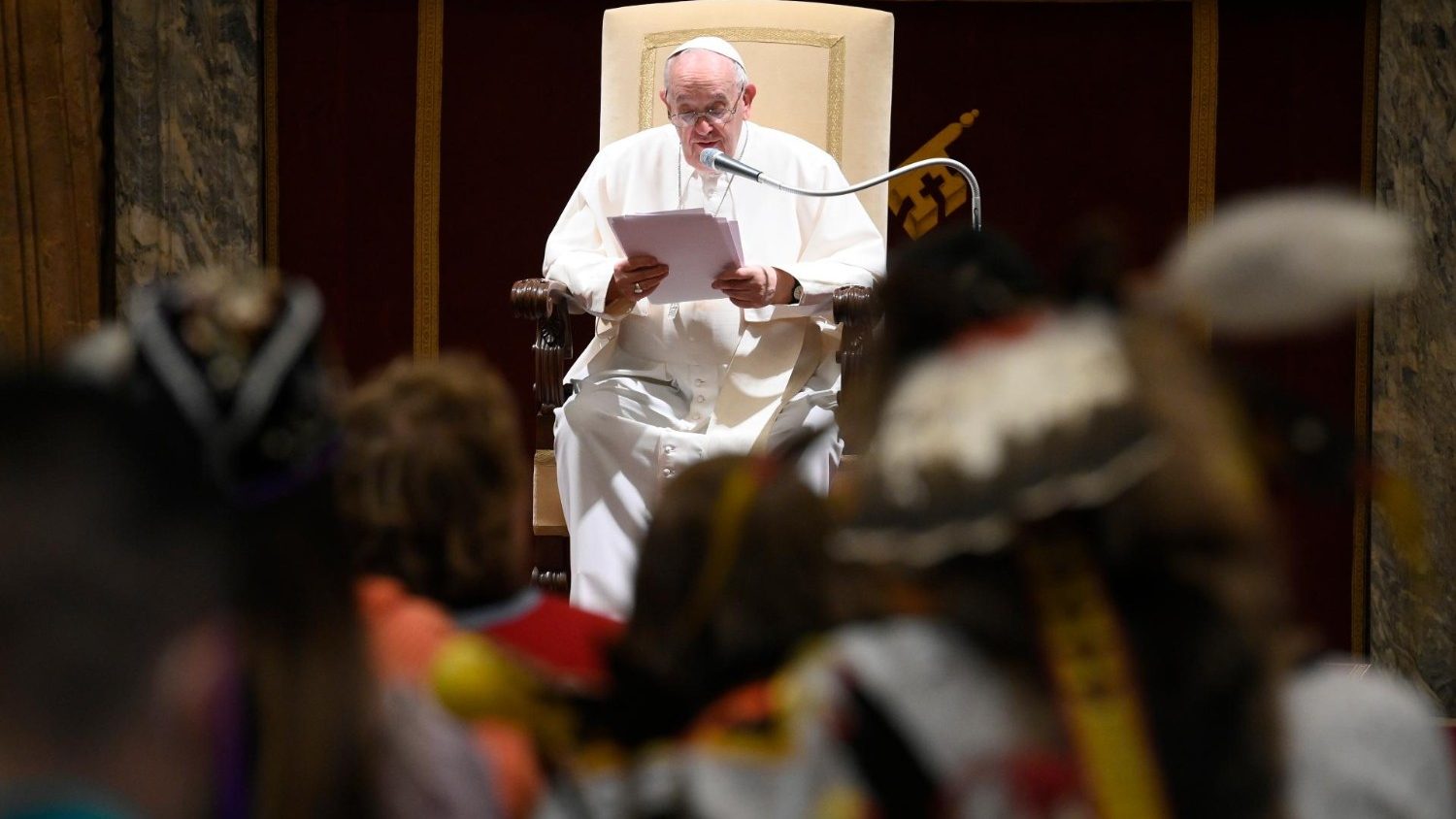The director of the Press Office of the Holy See illustrated the program of the Sovereign Pontiff during his trip to Canada, from July 24 to 30, a penitential pilgrimage, to continue the path of reconciliation undertaken in recent months with the Métis, the Inuit and the First Nations, indigenous peoples affected during the colonial era by policies of cultural assimilation.
Tiziana Campisi – Vatican News
It will be, as he said himself in the last Angelus, a “penitential pilgrimage”. The director of the Press Office of the Holy See, Matteo Bruni, highlighted this particularity of the apostolic trip that Pope Francis will make to Canada, from July 24 to 30, during the press conference held last Wednesday (07/20), presenting to the media the steps that Francisco will take in the North American country. A long-awaited trip that stems from five meetings that the Pontiff had between the end of March and the month of April with the Canadian indigenous people Métis, Inuit, First Nations and Métis Manitoba, and which aims to “meet and embrace” these communities , as Pope Francis made clear last Sunday. His next apostolic journey, with the motto “Walking together” and really wants to “contribute to the journey of healing and reconciliation undertaken” with the indigenous communities, seriously wronged, in the past and in different ways, by the policies of cultural assimilation in to which many Christians and also members of religious institutes have contributed. It will therefore not have the typical pattern of papal trips, but will be entirely focused on the journey of dialogue and listening, closeness and solidarity with the Canadian indigenous populations that the Pope began a few months ago. A journey begun by John Paul II in September 1984, when he met the Amerindians and the Inuit who asked the Pontiff to visit their lands during the beatification, on June 22, 1980, in Rome, of Kateri Tekakwitha, canonized on October 21 2012 by Benedict XVI, the first saint in North America.
The second apostolic journey of the Francis year
The one to Canada is the second apostolic trip that the Pope has made this year, after the visit to Malta on April 2 and 3 and the trip not made to Congo and South Sudan, from July 2 to 7, due to problems right leg. , with a new date to be set. Francis is the second pontiff to visit Canadian territory. Before him, there were three apostolic journeys of John Paul II: in 1984, in 1987 and in 2002. Invited by the civil, ecclesiastical and indigenous communities, Pope Francis will take off on Sunday at 9 a.m. local time from Fiumicino airport and will arrive, after more than 10 hours of flight to the city of Edmonton. He will be officially received at the airport in the capital of the province of Alberta, then he will go to St Joseph’s Seminary.
Meeting with First Nations, Métis and Inuit Indians
The pope will deliver four speeches, four homilies and a greeting in Spanish to a delegation of natives present in Quebec. The day after his arrival, he will meet the indigenous peoples of the First Nations, Métis and Inuit, to whom, on April 1, in the Vatican, he expressed his sadness and solidarity in the face of the tragedy of the eradication of so many people and families different from their lands and their cultures, between the 19th and 20th centuries, and to render recognition and justice to the victims of the “boarding schools” set up by the government and entrusted to the Christian Churches, including the Catholic Church. “I feel shame, pain and sadness for the role that many Catholics, especially with educational responsibilities, have played in all that has hurt them in abuse and disrespect for their identity. , their culture and even their spiritual values to the Gospel of Jesus,” the Supreme Pontiff said during the audience with the three delegations. On this occasion, the pope also joined in the apologies of the Canadian bishops, declaring that “the content of the faith cannot be transmitted in a way foreign to the faith itself”, thus giving counter-witness, and adding that “Jesus taught us to welcome, to love, to serve and not to judge”. Francis’ days in Canada will grow along this path, the director of the Holy See’s Press Office said, but at the heart of the Pontiff will also be the theme that is very dear to him of the care of creation, as it is for the indigenous peoples.
Saint-Anne, a figure to which Canadians are very attached
On the afternoon of July 26, in memory of Saints Joaquim and Ana, grandparents of Jesus, Pope Francis will take part in the traditional pilgrimage dedicated to Saint Anne which has taken place for centuries on the lake of the same name, about 72 kilometers from Edmonton. The mother of the Virgin Mary is a figure to which Canadians are very attached, she is venerated in many Aboriginal communities and that of Lac Ste Anne – declared a national historic site by the Canadian government in 2004 – is one of the most important spiritual encounters for the faithful of North America and particularly for the peoples of the First Nations.
The Pope’s Other Meetings
There will be meetings with the civil authorities. For this reason, on July 27 Francis will travel to Quebec, while on July 28 he will celebrate Vespers with bishops, priests, deacons, consecrated persons, seminarians and pastoral workers at the National Shrine of Santa Ana. de Beaupré, from where he will leave a golden rose as a gift. Matteo Bruni recalls that in Canada there is also the Catholic community, indigenous and non-indigenous, which is confronted with a secularized world in which it wonders about the way of announcing the Gospel: the Pope will also be able to address to them in different ways, not forgetting today’s international scene and the war in Ukraine. On July 29, he will notably meet some members of the Society of Jesus, then three other meetings with the people of Quebec await him, the last, before leaving for Rome, will be with the young and the old.

“Prone to fits of apathy. Beer evangelist. Incurable coffeeaholic. Internet expert.”







